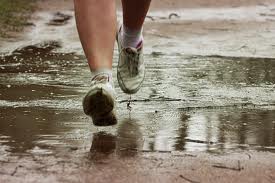We all remember inclement weather recess from our elementary school years. Rain, extreme heat, heavy winds or snow seem to automatically mean that staying indoors is required for play and exercise alike. Runners are a different breed. Many of us can be found outdoors in all weather and elements chasing our runner’s high. However, this is not always the preference of every runner. Some prefer to follow suit from elementary school and stay indoors on a treadmill or cycle to workout in shelter until the sun shines mildly again. So what is the best option for inclement weather? The answer to this question depends on the stage of training you are in and what your goals are.
Good Race Preparation
If you are training for a race such as a half or full marathon, it is recommended that you attempt to train in inclement weather. The reason for this is obvious; the race will be held outdoors. I will never forget the year that I ran a race in February along the California coastline blinded by rain and facing fierce wind resistance every step of the 13.1 mile course. That beast of a run was undertaken with few preparations for what the weather offered that day. I had trained only in decent, sunny weather and hid from the rain and wind in the gym on the treadmill. In a similar circumstance, I ran a full marathon several months later in melting 90 degree weather. This time, I was better prepared because I had forced myself to run outdoors during the summer months when I would normally have gone to the gym. Still, my predawn runs were no match for the late morning heat of the marathon, even though I had prepared well for the distance. The heat slowed my time significantly and I left disappointed.
The best way to train in inclement weather is to treat it as a worst case scenario race day preparation. When you step out onto the trail or road for a training run in inclement weather, you are preparing yourself to meet the same elements on race day. One of the biggest warnings given to runners is not to do anything different the day of a race so that you can avoid the mishaps common in our sport. The weather is out of our control; best to meet it or seek it on a training run.
Dress for Success
Also, make sure to have proper gear and accessories. It is not advisable to run in shorts and a sports bra in freezing rain or without a hat and sunscreen in melting heat. In regions where it snows part of the year, layers of warm clothing works best. On days where the weather may impair driving, it is advisable to wear a head lamp or at the very least, bright clothing. This makes you visible to drivers who may be distracted by the rain or snow. If you are facing fierce winds, make sure to wear sunglasses to protect your eyes from sand and other objects that may take flight.
Embrace the Suck
Running in inclement weather can certainly be an adventure for the runner who is fed up with the same old routine day in and day out. Finding your pace during the worst of weather can make for a victorious run when the skies regain their calm; conquering one day of bad weather is good for several more days of running with the knowledge that you have run through worse.

